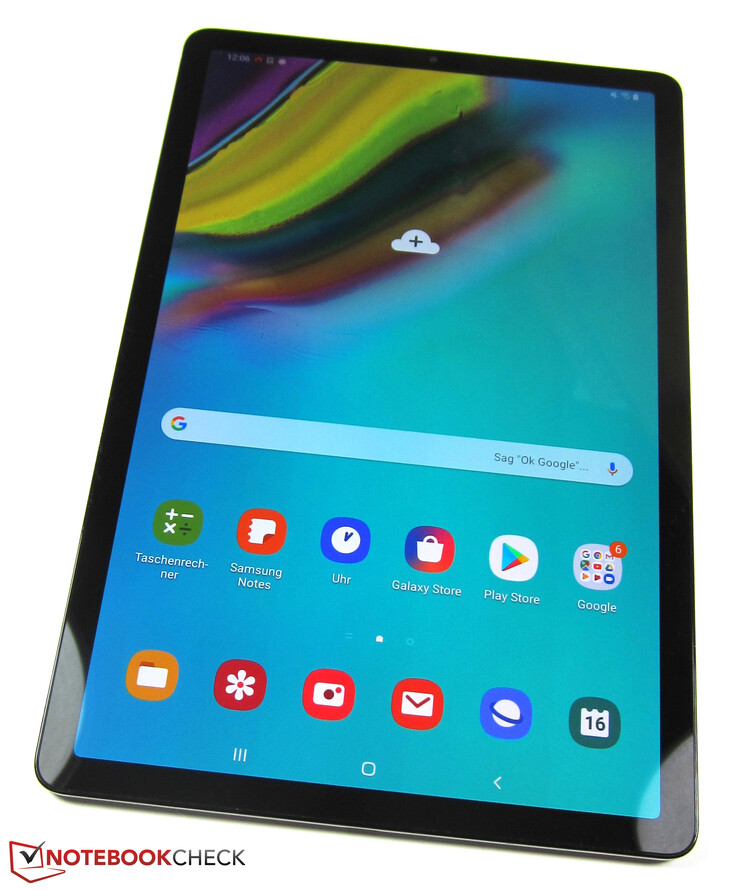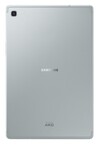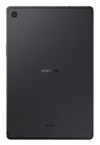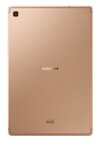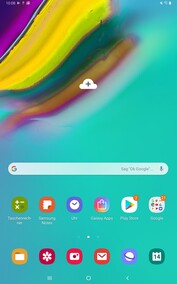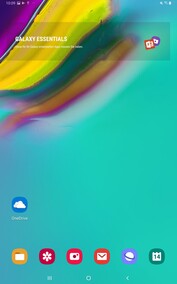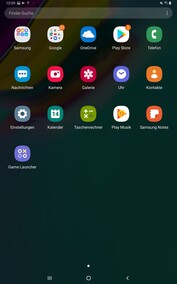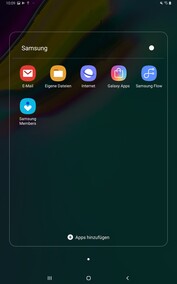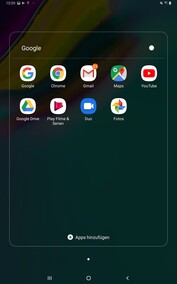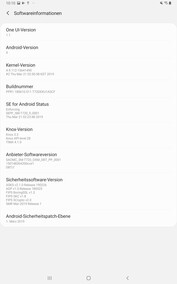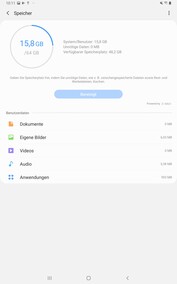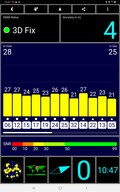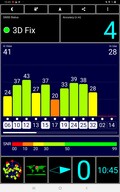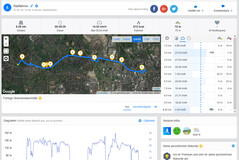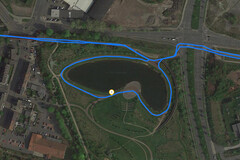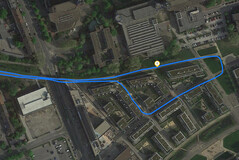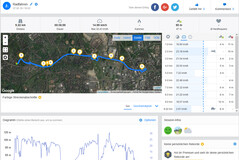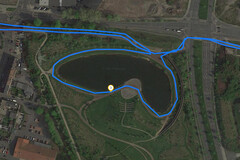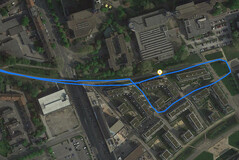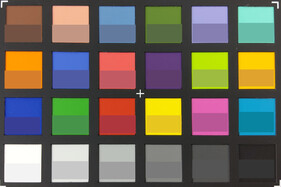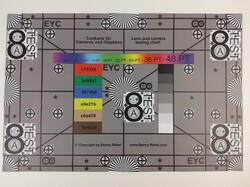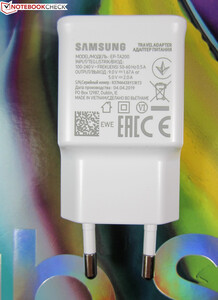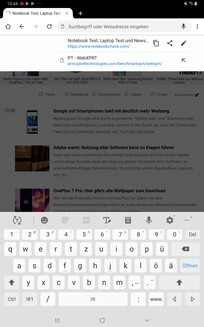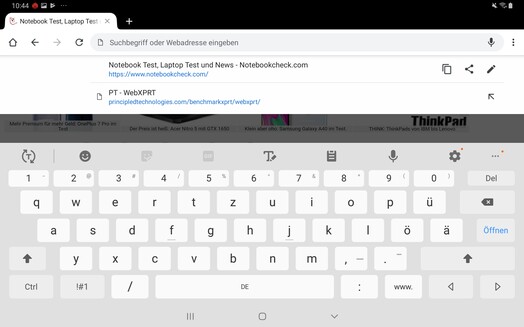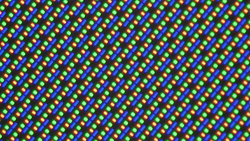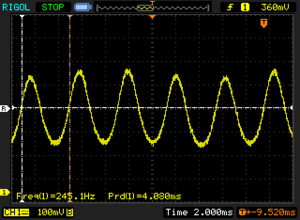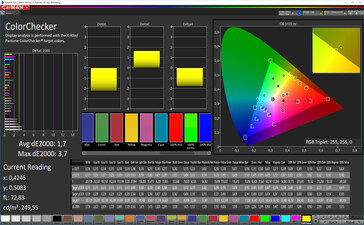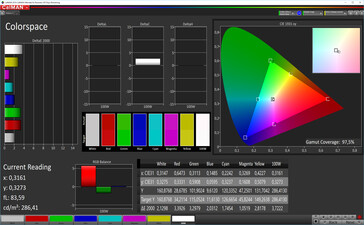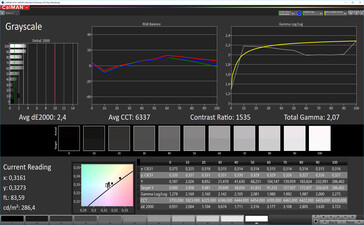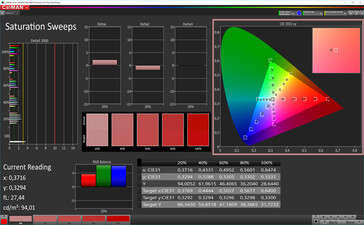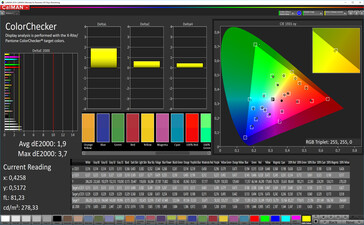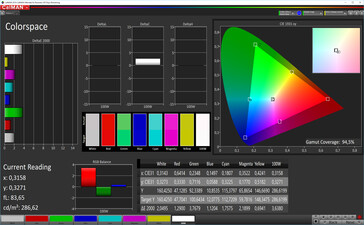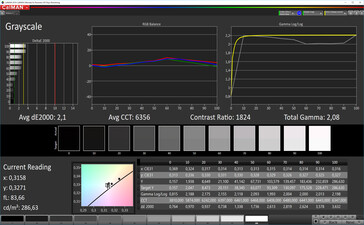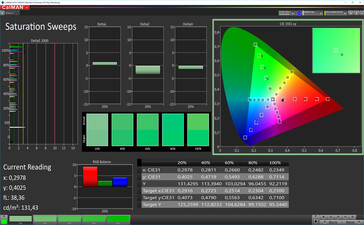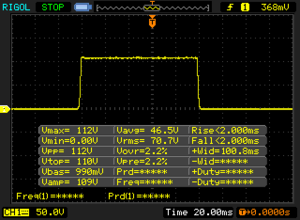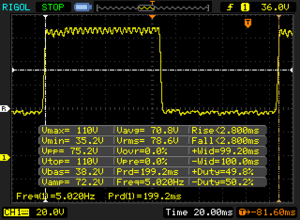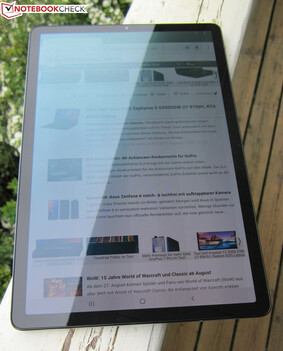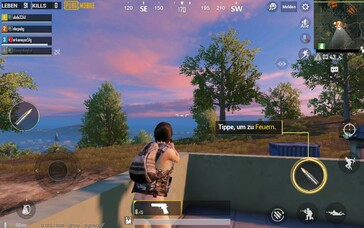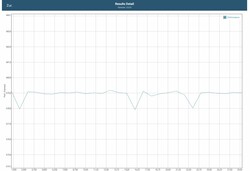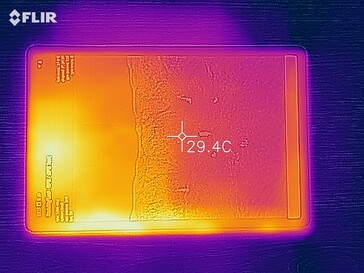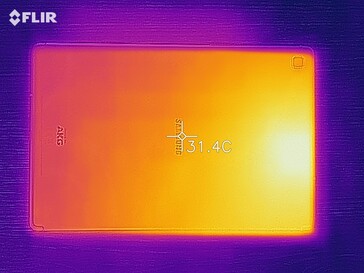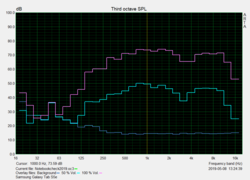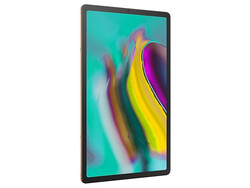Samsung Galaxy Tab S5e (Wi-Fi) Tablet Review
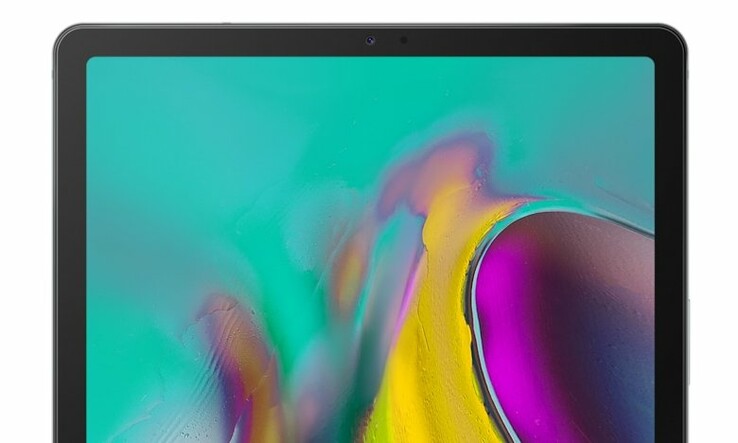
Samsung is slowly expanding its Galaxy Tab S series. First, we had the Tab S4, which scored highly in our review at the end of last year. Now we have its cheaper sibling, the Tab S5e. The latter has inherited plenty of hardware from its big brother while shaving off nearly 100 g and 300 Euros (~$336).
Both devices have 10.5-inch Super AMOLED displays that operate at 2560x1600 along with quad speakers, 4 GB of RAM and 64 GB of internal storage. A word on the storage though: While the Tab S4 has UFS 2.1 storage, the Tab S5e has eMMC flash storage instead, which is considerably slower. Both devices support Samsung DeX and have LTE variants too.
Moreover, the Tab S5e does not support pen input like its bigger brother, while Samsung equips it with a Qualcomm Snapdragon 670 SoC. By contrast, the Tab S4 is powered by the more powerful Snapdragon 835.
We have chosen to compare the Tab S5e against the Tab S4 along with the Apple iPad Air (2019), Amazon Fire HD 10 (2017), Huawei MediaPad M5 10.8 and the Lenovo Tab P10.
Case
The Tab S5e certainly looks more expensive than it is. Its black, gold or silver metal chassis makes the tablet look premium, as do its slim display bezels. The device weighs just 400 grams too, making the Tab S5e one of the lightest 10-inch tablets currently on the market.
Our review unit weighs at least 40 g less than our comparison devices, although we could hardly notice this difference in daily use. Overall, the Tab S5e feels good in the hand thanks to its rounded corners, and it never felt heavy even if we had been carrying it around for a while.
We thought that the Apple iPad Air (2019) was thin, but the Tab S5e takes this to new extremes. Our review unit is 5.5 mm thick, which currently makes it the thinnest 10-inch tablet that we have ever tested. We should point out that the rear-facing camera protrudes from the back case by around 1 mm, so technically the Tab S5e is 6.5 mm thick. The camera housing has a large contact area though, so it does not make the tablet wobble about when placed on a flat surface. Samsung has also incorporated the fingerprint scanner within the home button, which sits on the right-hand side of the device. We were pleasantly surprised to see the South Korean company include a fingerprint scanner, seeing as it failed to do so with the Tab S4. Advantage Tab S5e, then.
You can twist and temporarily deform the Tab S5e by applying some force if you are into that sort of thing. Likewise, we can depress the screen by approximately 1 mm, but we did not notice this happening in daily use. Hence, you should not find your Tab S5e bent if you take it out of your bag, for example. The tablet has no IP certification though, so it is not officially dust or water-resistant. We would recommend looking after your electronics even if they are IP or MIL-STD certified but be careful to keep the Tab S5e away from water.
Samsung covers the front of the tablet in Gorilla Glass 3, while all colours come with black display bezels on the frame. We measure these at about 9 mm on all sides, which makes it look sleeker than the Tab S4 in our opinion.
Connectivity
As mentioned at the start of this review, the Tab S5e is powered by a Qualcomm Snapdragon 670 SoC, which integrates a Kryo 360 CPU and an Adreno 616 GPU among other components. Samsung complements the SoC with 4 GB of LPDDR4X RAM and 64 GB of eMMC flash storage, of which approximately 48 GB is free upon delivery. The Tab S5e supports up to 512-GB microSD cards should you need more storage. The tablet can save apps and data on external storage too.
Our review unit is the Wi-Fi model, but Samsung also sells an LTE version should you always need Internet access. The card slot in the LTE version holds a microSD card and a SIM card, for reference. Disappointingly, neither version supports NFC, so the Tab S5e cannot be used with services like Google Pay, for example.
Samsung has equipped the Tab S5e with a USB 3.1 Gen.1 Type-C port, which supports USB On-The-Go (OTG) along with audio and video out. These allow the tablet to work with Samsung DeX, the South Korean company’s desktop mode, but you will need a Type-C to HDMI or DisplayPort adapter to take advantage of the feature.
The Tab S5e also has a set of pogo pins on its left-hand side, to which you can connect the Bookcover, Keyboard Cover or Charging Dock POGO docking station. All connect magnetically to the device.
Software
The Tab S5e ships with One UI 1.1 at the time of writing, which is Samsung’s customised version of Android 9.0 Pie. The UI looks subtly different compared to stock Android Pie, so it should not take too long to get acclimatised if you have used Android before. Our review unit had March 2019 security patches installed during our tests in April, which make them still quite up to date. As befits a modern multimedia tablet, the Tab S5e can stream DRM-protected content in HD from services like Amazon Prime Video and Netflix thanks to its DRM Widevine L1 certification.
One UI comes with hardly any third-party apps preinstalled save for the usual suite of Google apps, and some Microsoft apps like OneDrive. Samsung also includes its Galaxy Apps app store along with other services like E-Mail, Samsung Members and Bixby Home. While the Tab S5e does not have a dedicated Bixby button like recent Galaxy S smartphones do, swiping to the right from the home screen brings up the service, which displays information like reminders, app notifications and weather among others.
As mentioned previously, the Tab S5e also supports Samsung DeX, which replaces One UI with something akin to a Windows-esque desktop view when enabled. Connecting an optional Keyboard Cover allows you to use the Tab S5e like a small laptop. Android supports mouse input too, although you will need to connect an external one as the Keyboard Cover does not have a trackpad. It is a shame that Samsung chose to not bring pen support to the Tab S5e though, which could have been useful for creatives or professionals.
Communication & GPS
The Tab S5e supports Bluetooth 5.0 and modern Wi-Fi standards up to IEEE 802.11ac, which allows the device to connect to 2.4 GHz or 5.0 GHz Wi-Fi networks. The LTE variant currently costs around 60 Euros (~$67) more than its Wi-Fi equivalent and supports 13 LTE bands including Band 20, which has been deployed across Europe.
Our review unit achieved good, but not outstanding, Wi-Fi transfer speeds in tests with our Linksys EA8500 router. The Tab S5e finished second to the iPad Air (2019) in iperf3 Client (receive) and even outperformed the Tab S4, but it could only finish fourth in the iperf3 Client (transmit) test.
The Tab S5e uses BeiDou, Galileo, GLONASS and GPS for location services, which allows it to find a satellite fix with up to four metres accuracy regardless of where we test it.
We also took our review unit on a bike ride to test its location accuracy against the Garmin Edge 500, a dedicated bike computer. The Tab S5e performed impressively well here and even manages to plot a more realistic route than the Garmin did. In short, you should have no issues with using the Tab S5e as a sat nav, other than its size.
Cameras
The Tab S5e has two cameras, a 13 MP rear-facing sensor and an 8 MP front-facing one. The former has a 1/4" CMOS sensor that can take photographs in up to 4128x3096 with a 4:3 aspect ratio and shoot 4K videos at 30 FPS. By contrast, the 8 MP front-facing sensor can only produce 3264x2448 pixels photos, also with a 4:3 aspect ratio, and it can shoot videos in up to Full HD at 30 FPS.
Both sensors have f/2.0 apertures, although only the rear-facing one supports autofocus. The default camera app contains settings for adjusting the level of exposure, ISO, and white balance. The app also has gesture controls, geotagging, an HDR mode, a beauty mode and filters including selfie stickers. Samsung has integrated Bixby Vision too, which has AR features and can translate texts, and identify products along with reading QR codes.
The rear-facing camera takes passable photos in daylight as demonstrated by scenes 1 and 2 below. However, they both look rather dull and washed-out. The sensor struggles to capture many details, even in ideal conditions too. Photos shot in low light amplify these shortcomings. Scene 3, for instance, is so underexposed that it is difficult to make out any details. In short, the cameras are good enough for occasionally taking the odd photo or selfie, but not much else.
We also subjected our review unit to further camera tests under controlled lighting conditions. The rear-facing camera tends to oversaturate bright colours and grey tones compared to ColorChecker: Passport reference colours.
The Tab S5e does a decent job at capturing our test chart though. The camera reproduces fine details and structure, but the image is not as sharp as we would have liked it to be. Moreover, contrast levels drop off in the bottom corners of the chart, which makes those areas look washed-out.
Accessories & Warranty
Samsung includes a 15 W modular charger in the box (9 V/1.67 A, 5 V/2 A) along with a USB Type-A to Type-C cable, a Type-C to 3.5 mm jack adapter and a card slot opening tool. Our review unit comes with a quick-start guide and some warranty information too.
As mentioned earlier in this review, Samsung also sells four Tab S5e specific accessories, called the Bookcover, Keyboard Cover, Charging Dock POGO docking station and Slim Cover. You can also buy a Type-C to HDMI cable, which the South Korean company markets as a DeX Cable. The cable is 1.3 m long and supports 4K at 60 Hz.
Input Devices & Operation
The Tab S5e worked smoothly during our tests in part because of its 10-point multitouch touchscreen, which reproduced inputs precisely and without any noticeable delays. We had no issues with the power button or volume rocker either, which both sit firmly in their housings and are defined by their crisp pressure points.
As mentioned in the Connectivity section of this review, Samsung has integrated a fingerprint scanner within the power button, which can recognise up to three fingerprints. The scanner worked well in our tests and only required us to place our finger on its surface for it to unlock our review unit. Alternatively, you could use facial authentication to unlock the device from standby, but please be aware that this is not as secure as using the fingerprint scanner.
To reiterate, the Tab S5e does not support pen input. You can transform the tablet into a quasi-laptop with the optional Keyboard Cover though. Unfortunately, we were unable to test the cover or the other two optional accessories that Samsung currently sells for the Tab S5e.
Display
The Tab S5e has a Super AMOLED 10.5-inch display like the Tab S4. Both devices operate natively at 2560x1600 and have a pixel density of 287 PPI. Content looks sharp thanks to the high resolution, and the 16:10 aspect ratio lends itself to watching movies. Samsung has not specified whether the Tab S5e supports HDR though, and we were unable to clarify this during our tests.
Our review unit achieved an average maximum brightness of 453 cd/m² and has a 91% evenly lit display, according to X-Rite i1Pro 2. Meanwhile, the more practical APL50 test reports that the panel reaches 530 cd/m². Switching off the ambient light sensor reduces the maximum brightness to 299 cd/m² though. The display can also get as dark as 1.74 cd/m², so the Tab S5e should not strain your eyes if you are using it at night or in a dark room for prolonged periods.
Unfortunately, the tablet uses pulse-width modulation (PWM) to regulate display brightness, which can cause eye strain and headaches for some people. The display in our test device flickers at 245.1 Hz when below 100% brightness, which is low enough of a frequency to cause issues for those who are PWM sensitive.
| |||||||||||||||||||||||||
Brightness Distribution: 90 %
Center on Battery: 452 cd/m²
Contrast: ∞:1 (Black: 0 cd/m²)
ΔE ColorChecker Calman: 1.7 | ∀{0.5-29.43 Ø4.78}
ΔE Greyscale Calman: 2.4 | ∀{0.09-98 Ø5}
97.5% sRGB (Calman 2D)
Gamma: 2.07
CCT: 6337 K
| Samsung Galaxy Tab S5e SM-T720 Super AMOLED, 2560x1600, 10.5" | Amazon Fire HD 10 2017 IPS, 1920x1200, 10.1" | Apple iPad Air 3 2019 IPS, 2224x1668, 10.5" | Huawei MediaPad M5 10.8 IPS, 2560x1600, 10.8" | Lenovo Tab P10 IPS, 1920x1200, 10.1" | Samsung Galaxy Tab S4 Super AMOLED, 2560x1600, 10.5" | |
|---|---|---|---|---|---|---|
| Screen | -69% | -2% | -34% | -131% | -14% | |
| Brightness middle (cd/m²) | 452 | 426 -6% | 515 14% | 382 -15% | 522 15% | 474 5% |
| Brightness (cd/m²) | 453 | 399 -12% | 483 7% | 378 -17% | 495 9% | 477 5% |
| Brightness Distribution (%) | 90 | 91 1% | 90 0% | 92 2% | 84 -7% | 91 1% |
| Black Level * (cd/m²) | 0.38 | 0.41 | 0.24 | 0.41 | ||
| Colorchecker dE 2000 * | 1.7 | 4.5 -165% | 1.6 6% | 2.8 -65% | 6.7 -294% | 2.5 -47% |
| Colorchecker dE 2000 max. * | 3.7 | 7.9 -114% | 4.4 -19% | 6 -62% | 12.2 -230% | 5.8 -57% |
| Greyscale dE 2000 * | 2.4 | 5.2 -117% | 2.8 -17% | 3.5 -46% | 9.1 -279% | 2.1 12% |
| Gamma | 2.07 106% | 2.23 99% | 2.21 100% | 2.33 94% | 2.14 103% | 2.08 106% |
| CCT | 6337 103% | 6875 95% | 6944 94% | 6903 94% | 9417 69% | 6281 103% |
| Contrast (:1) | 1121 | 1256 | 1592 | 1273 |
* ... smaller is better
Screen Flickering / PWM (Pulse-Width Modulation)
| Screen flickering / PWM detected | 245.1 Hz | ≤ 99 % brightness setting | |
The display backlight flickers at 245.1 Hz (worst case, e.g., utilizing PWM) Flickering detected at a brightness setting of 99 % and below. There should be no flickering or PWM above this brightness setting. The frequency of 245.1 Hz is relatively low, so sensitive users will likely notice flickering and experience eyestrain at the stated brightness setting and below. In comparison: 53 % of all tested devices do not use PWM to dim the display. If PWM was detected, an average of 8111 (minimum: 5 - maximum: 343500) Hz was measured. | |||
Samsung includes four display modes, the default of which is Adaptive Display. This automatically adjusts the colour temperature of the display according to what is currently being displayed. CalMAN analysis software and our spectrophotometer demonstrate that the Simple and AMOLED Photo modes reproduce colours more naturally than the AMOLED Cinema mode does.
Our review unit has impressively low DeltaE deviations regardless of which display mode is active though. Likewise, its colour temperature is just shy of the ideal value of 6,500 K. Moreover, the AMOLED panel has a theoretically infinite contrast ratio and a 0 cd/m² black value thanks to being able to switch off its pixels individually. In short, the Tab S5e has a mighty impressive display for a tablet at this price.
Display Response Times
| ↔ Response Time Black to White | ||
|---|---|---|
| 4 ms ... rise ↗ and fall ↘ combined | ↗ 2 ms rise | |
| ↘ 2 ms fall | ||
| The screen shows very fast response rates in our tests and should be very well suited for fast-paced gaming. In comparison, all tested devices range from 0.1 (minimum) to 240 (maximum) ms. » 15 % of all devices are better. This means that the measured response time is better than the average of all tested devices (20.2 ms). | ||
| ↔ Response Time 50% Grey to 80% Grey | ||
| 5.6 ms ... rise ↗ and fall ↘ combined | ↗ 2.8 ms rise | |
| ↘ 2.8 ms fall | ||
| The screen shows very fast response rates in our tests and should be very well suited for fast-paced gaming. In comparison, all tested devices range from 0.165 (minimum) to 636 (maximum) ms. » 17 % of all devices are better. This means that the measured response time is better than the average of all tested devices (31.6 ms). | ||
The Tab S5e is also a pleasure to use outdoors thanks to its bright and contrast-rich display. Its ambient light sensor adjusts brightness quickly too. However, the display’s highly reflective finish catches the sun, which makes content look washed-out.
We had no issues with viewing angles though, which remained excellent throughout our tests. We noticed no brightness, colour or image distortions even at acute angles, so you should have no problem with reading the Tab S5e from practically any angle.
Performance
As mentioned in previous sections of this review, Samsung has equipped the Tab S5e with a Qualcomm Snapdragon 670 SoC, an ARMv8-based midrange chip SoC that has also found a home in devices like the Pixel 3a and Pixel 3a XL. The Snapdragon 670 has up to 15% better CPU performance than its predecessor, the Snapdragon 660, and up to double the AI performance. The Snapdragon 670 integrates the Kryo 360 CPU, an octa-core processor that has two performance cores and six power-saving cores, which can clock up to 2 GHz and 1.7 GHz, respectively.
The Snapdragon 670 also integrates an Adreno 616 GPU, which, along with the 4 GB LPDDR4X RAM that Samsung has included, helps the Tab S5e perform well in everyday tasks. We experienced practically no loading times during our time with the tablet, with apps loading quickly. The system did not lag or stutter either, even during heavy multitasking.
The Tab S5e and its Snapdragon 670 SoC cannot cut it against the more powerful chips found in the iPad Air (2019) and Tab S4 of our comparison devices. Our review unit nearly matched the performance of the MediaPad M5 10.8 though, which was one of the most powerful tablets just when it came out last year. In short, the Tab S5e has enough performance to cope with whatever you throw at it and is no slouch compared to other more powerful tablets.
| Basemark GPU 1.1 | |
| 1920x1080 Vulkan Medium Offscreen | |
| Samsung Galaxy Tab S4 | |
| Average Qualcomm Snapdragon 670 (12 - 12.5, n=2) | |
| Samsung Galaxy Tab S5e SM-T720 | |
| Vulkan Medium Native | |
| Samsung Galaxy Tab S4 | |
| Average Qualcomm Snapdragon 670 (7.67 - 11.6, n=2) | |
| Samsung Galaxy Tab S5e SM-T720 | |
| 1920x1080 OpenGL Medium Offscreen | |
| Samsung Galaxy Tab S4 | |
| Average Qualcomm Snapdragon 670 (13.1 - 13.8, n=2) | |
| Samsung Galaxy Tab S5e SM-T720 | |
| VRMark - Amber Room | |
| Samsung Galaxy Tab S4 | |
| Average Qualcomm Snapdragon 670 (1423 - 1473, n=2) | |
| Samsung Galaxy Tab S5e SM-T720 | |
| Average of class Tablet (n=1last 2 years) | |
| Basemark ES 3.1 / Metal - offscreen Overall Score | |
| Apple iPad Air 3 2019 | |
| Average of class Tablet (255 - 5784, n=10, last 2 years) | |
| Average Qualcomm Snapdragon 670 (444 - 447, n=2) | |
| Samsung Galaxy Tab S5e SM-T720 | |
The same goes for browser benchmarks, where the Tab S5e typically ranks behind the iPad Air (2019) and Tab S4 in the upper midfield of our comparison tables. Web-browsing should feel smoother on the Tab S5e than it would on the Fire HD 10 or Tab P10 too.
| Jetstream 2 - 2.0 Total Score | |
| Average of class Tablet (22.3 - 395, n=67, last 2 years) | |
| Apple iPad Air 3 2019 (Safari Mobile 12) | |
| Samsung Galaxy Tab S5e SM-T720 (Chrome 74.0.3729.136) | |
| Average Qualcomm Snapdragon 670 (32.1 - 33.6, n=4) | |
| WebXPRT 3 - Overall | |
| Average of class Tablet (39 - 480, n=25, last 2 years) | |
| Apple iPad Air 3 2019 (Safari Mobile 12) | |
| Samsung Galaxy Tab S4 (Samsung Browser 8.0) | |
| Samsung Galaxy Tab S5e SM-T720 (Chrome 74.0.3729.136) | |
| Average Qualcomm Snapdragon 670 (53 - 66, n=3) | |
| Speedometer 2.0 - Result 2.0 | |
| Average of class Tablet (2.59 - 790, n=55, last 2 years) | |
| Apple iPad Air 3 2019 (Safari Mobile 12) | |
| Samsung Galaxy Tab S5e SM-T720 (Chrome 74.0.3729.136) | |
| Average Qualcomm Snapdragon 670 (29.6 - 33.7, n=3) | |
| Octane V2 - Total Score | |
| Average of class Tablet (763 - 138481, n=95, last 2 years) | |
| Apple iPad Air 3 2019 (Safari Mobile 12) | |
| Samsung Galaxy Tab S4 (Samsung Browser 8.0) | |
| Samsung Galaxy Tab S5e SM-T720 (Chrome 74.0.3729.136) | |
| Average Qualcomm Snapdragon 670 (10245 - 11312, n=4) | |
| Amazon Fire HD 10 2017 (Amazon Silk 61.2) | |
| Huawei MediaPad M5 10.8 (Chrome 65) | |
| Lenovo Tab P10 (Chrome 71) | |
| Mozilla Kraken 1.1 - Total | |
| Lenovo Tab P10 (Chrome 71) | |
| Huawei MediaPad M5 10.8 (Chrome 65) | |
| Amazon Fire HD 10 2017 (Amazon Silk 61.2) | |
| Average Qualcomm Snapdragon 670 (3361 - 3655, n=4) | |
| Samsung Galaxy Tab S5e SM-T720 (Chrome 74.0.3729.136) | |
| Samsung Galaxy Tab S4 (Samsung Browser 8.0) | |
| Average of class Tablet (243 - 27101, n=80, last 2 years) | |
| Apple iPad Air 3 2019 (Safari Mobile 12) | |
* ... smaller is better
The Tab S5e has above average eMMC flash storage according to AndroBench 3-5. Our review unit achieved around 6% high transfer speeds than what we would have expected from a device with 64 GB of eMMC flash storage, and it finished leagues ahead of the Fire HD 10 and the Tab P10. The eMMC storage is well beaten by the UFS 2.1 storage in the Tab S4 though.
However, our test device finished roughly on par with its more expensive sibling in microSD card benchmarks. We tested all devices in our comparison table with our Toshiba Exceria Pro M501 reference card to remove any card-related variables. Overall, the performance of the microSD card reader in the Tab S5e is closer to those of premium tablets rather than budget ones like the Fire HD 10.
| Samsung Galaxy Tab S5e SM-T720 | Amazon Fire HD 10 2017 | Huawei MediaPad M5 10.8 | Lenovo Tab P10 | Samsung Galaxy Tab S4 | Average 64 GB eMMC Flash | Average of class Tablet | |
|---|---|---|---|---|---|---|---|
| AndroBench 3-5 | -38% | 29% | -7% | 44% | 7% | 674% | |
| Sequential Read 256KB (MB/s) | 294.4 | 262.2 -11% | 247.8 -16% | 276.7 -6% | 741 152% | 277 ? -6% | 1805 ? 513% |
| Sequential Write 256KB (MB/s) | 197.1 | 147.7 -25% | 126.8 -36% | 205.7 4% | 195.8 -1% | 178.4 ? -9% | 1347 ? 583% |
| Random Read 4KB (MB/s) | 79.2 | 27.72 -65% | 54.7 -31% | 53.9 -32% | 142 79% | 60.7 ? -23% | 246 ? 211% |
| Random Write 4KB (MB/s) | 18.79 | 9.37 -50% | 60.8 224% | 15.75 -16% | 24.43 30% | 33.8 ? 80% | 280 ? 1390% |
| Sequential Read 256KB SDCard (MB/s) | 76.1 ? | 55.5 ? -27% | 85.1 ? 12% | 84.3 ? 11% | 80.1 ? 5% | 77.4 ? 2% | |
| Sequential Write 256KB SDCard (MB/s) | 60.8 ? | 30.14 ? -50% | 73.8 ? 21% | 61 ? 0% | 59.1 ? -3% | 58.3 ? -4% |
Games
The Adreno 616 is a competent GPU that can handle all modern games smoothly. Even complex titles like PUBG Mobile run smoothly, as demonstrated by our GameBench frame-rate tables below. Please note that the low frame rates at the start of each graph are when the game is loading up; they do not represent gameplay frame rates.
The Dolby Atmos quad speakers help deliver an immersive experience in games. The device uses its accelerometer to calibrate the speakers to whichever way you are holding them, which is a nice touch.
PUBG Mobile
Dead Trigger 2
Shadow Fight 3
Emissions
Temperature
Our review unit maintains its surface temperatures well and only reached a maximum of 29.6 °C at idle during our tests. The whole device averaged a marginally cooler 28.5 °C under these conditions though. Surface temperatures rose to only a maximum of 33.1 °C under load with most of the device remaining around 30 °C or cooler. Thus, the Tab S5e should never feel hot to the touch even if you are pushing it hard.
The tablet manages its internal temperatures well too. Our review unit maintained consistent frame rates during the GFXBench Manhattan benchmark, which we ran on a loop for 30 times. In short, you should experience no thermal throttling during prolonged gaming sessions.
(+) The maximum temperature on the upper side is 33.1 °C / 92 F, compared to the average of 33.7 °C / 93 F, ranging from 20.7 to 53.2 °C for the class Tablet.
(+) The bottom heats up to a maximum of 31.2 °C / 88 F, compared to the average of 33.2 °C / 92 F
(+) In idle usage, the average temperature for the upper side is 28.8 °C / 84 F, compared to the device average of 30 °C / 86 F.
Speakers
Samsung has equipped the Tab S5e with four AKG-branded speakers just like the Tab S4. The speakers also support Dolby Atmos as we mentioned elsewhere in this review.
The quad speakers sound excellent by tablet standards, delivering balanced mid and high tones, albeit with a distinct absence of bass tones. We noticed no rattles or distortions even at the maximum of 83.3 dB(A) that the speakers reached in our tests.
You could use external speakers or headphones instead for a better listening experience. You could do so either via Bluetooth or with the included USB Type-C adapter if you have wired audio equipment.
Samsung Galaxy Tab S5e SM-T720 audio analysis
(+) | speakers can play relatively loud (83.3 dB)
Bass 100 - 315 Hz
(±) | reduced bass - on average 14.3% lower than median
(±) | linearity of bass is average (10.4% delta to prev. frequency)
Mids 400 - 2000 Hz
(+) | balanced mids - only 2.8% away from median
(+) | mids are linear (2.8% delta to prev. frequency)
Highs 2 - 16 kHz
(+) | balanced highs - only 1.9% away from median
(+) | highs are linear (3.8% delta to prev. frequency)
Overall 100 - 16.000 Hz
(+) | overall sound is linear (12% difference to median)
Compared to same class
» 15% of all tested devices in this class were better, 5% similar, 80% worse
» The best had a delta of 7%, average was 21%, worst was 129%
Compared to all devices tested
» 9% of all tested devices were better, 2% similar, 89% worse
» The best had a delta of 4%, average was 24%, worst was 134%
Huawei MediaPad M5 10.8 audio analysis
(±) | speaker loudness is average but good (79.9 dB)
Bass 100 - 315 Hz
(±) | reduced bass - on average 11.9% lower than median
(-) | bass is not linear (16.4% delta to prev. frequency)
Mids 400 - 2000 Hz
(+) | balanced mids - only 3.2% away from median
(+) | mids are linear (5.7% delta to prev. frequency)
Highs 2 - 16 kHz
(+) | balanced highs - only 4.6% away from median
(+) | highs are linear (6.9% delta to prev. frequency)
Overall 100 - 16.000 Hz
(±) | linearity of overall sound is average (15.9% difference to median)
Compared to same class
» 37% of all tested devices in this class were better, 6% similar, 58% worse
» The best had a delta of 7%, average was 21%, worst was 129%
Compared to all devices tested
» 24% of all tested devices were better, 5% similar, 71% worse
» The best had a delta of 4%, average was 24%, worst was 134%
Power Management
Power Consumption
The Tab S5e is a comparatively power-efficient tablet and consumed a maximum of just 5.7 W in our tests. By contrast, tablets like the iPad Air (2019) and MediaPad M5 10.8 consume considerably more than our test device. The Tab S4 is not far behind its cheaper sibling, but the Tab S5e takes the crown here.
| Off / Standby | |
| Idle | |
| Load |
|
Key:
min: | |
| Samsung Galaxy Tab S5e SM-T720 7040 mAh | Amazon Fire HD 10 2017 6300 mAh | Apple iPad Air 3 2019 8134 mAh | Huawei MediaPad M5 10.8 7500 mAh | Lenovo Tab P10 7000 mAh | Samsung Galaxy Tab S4 7300 mAh | |
|---|---|---|---|---|---|---|
| Power Consumption | -26% | -60% | -56% | -3% | -8% | |
| Idle Minimum * (Watt) | 2.07 | 1.55 25% | 2.18 -5% | 2.01 3% | 1.01 51% | 1.76 15% |
| Idle Average * (Watt) | 3.94 | 4.17 -6% | 6.4 -62% | 5.4 -37% | 4.16 -6% | 4.22 -7% |
| Idle Maximum * (Watt) | 3.96 | 4.25 -7% | 6.43 -62% | 5.44 -37% | 4.17 -5% | 4.25 -7% |
| Load Average * (Watt) | 4.07 | 7.13 -75% | 7.48 -84% | 8.55 -110% | 5.45 -34% | 4.52 -11% |
| Load Maximum * (Watt) | 5.73 | 9.63 -68% | 10.65 -86% | 11.53 -101% | 6.9 -20% | 7.35 -28% |
* ... smaller is better
Battery Life
The Tab S5e also has excellent battery life, which reflects its comparatively low power consumption. Samsung equips the tablet with a 7,040 mAh battery that lasted for 10:23 hours in our practical Wi-Fi battery life test. This puts the Tab S5e in the midfield of our comparison devices, but the tablet excelled in our looped H.264 video test with a runtime of 14:24 hours. Overall, the Tab S5e finishes in second place to the Tab P10 in our comparison table. Incidentally, the Tab S4 generally has around 14% worse battery life than its cheaper sibling.
The included 15 W charger recharges our review unit in approximately 2:30 hours, for reference.
| Samsung Galaxy Tab S5e SM-T720 7040 mAh | Amazon Fire HD 10 2017 6300 mAh | Apple iPad Air 3 2019 8134 mAh | Huawei MediaPad M5 10.8 7500 mAh | Lenovo Tab P10 7000 mAh | Samsung Galaxy Tab S4 7300 mAh | |
|---|---|---|---|---|---|---|
| Battery runtime | -19% | -3% | -11% | 16% | -14% | |
| Reader / Idle (h) | 21.1 | 16 -24% | 25 18% | 22.4 6% | 21.9 4% | 20.5 -3% |
| H.264 (h) | 14.4 | 9.8 -32% | 11.4 -21% | 11.7 -19% | 15.2 6% | 12.3 -15% |
| WiFi v1.3 (h) | 10.4 | 9 -13% | 12.3 18% | 10.8 4% | 16.5 59% | 8.3 -20% |
| Load (h) | 5 | 4.6 -8% | 3.6 -28% | 3.3 -34% | 4.8 -4% | 4.1 -18% |
Pros
Cons
Verdict
The Samsung Galaxy Tab S5e is excellent value for money and an all-round solid tablet. The device has a bright and contrast-rich Super AMOLED 10.5-inch display and an SoC that can handle even the most complex of modern games. Likewise, its speakers provide an immersive in-game experience, while its battery life will not leave you short during long gaming or movie sessions.
The tablet is also well built and light, which is not always the case with midrange tablets. The metal design and thin display bezels make it look more expensive than it is too. Additionally, the inclusion of support for DeX and the optional keyboard cover makes the Tab S5e more than just a multimedia tablet.
There are some weak points, but these are few and far between. Samsung has equipped the tablet with average cameras, while the omission of an NFC chip is disappointing. We would also recommend trying out the Tab S5e in person if you are PWM sensitive as the display flickers at a frequency that may cause you eye strain and headaches during prolonged use.
The Samsung Galaxy Tab S5e is a worthy alternative to more expensive tablets like the Tab S4 and iPad Air (2019). It offers practically everything that most people would want from a tablet, but at a more affordable price and without many compromises.
Overall, the Tab S5e is not only one of the best value tablets that you could currently buy, but it also gives more powerful tablets a run for their money. The Tab S4 remains a better multimedia tablet overall though, because of its more powerful SoC, high capacity RAM and faster internal storage. The inclusion of pen support tips the scales in the Tab S4’s favour too.
Samsung Galaxy Tab S5e SM-T720
- 08/31/2022 v7 (old)
Manuel Masiero




